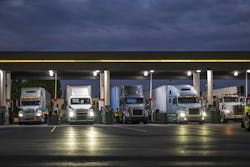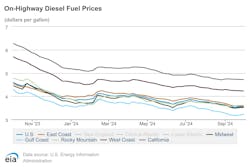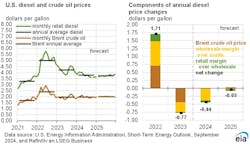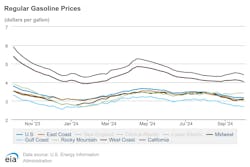Gas, diesel prices level off heading into October
As the country has experienced the arrival of Hurricane Helene and wrapped up September, the U.S. Energy Information Administration (EIA) found that the national average for diesel prices continued to inch up this week at $3.544 per gallon. This amount is less than a cent higher than last week, and down $1.05 from this time last year.
Across the country, diesel prices both rose and fell at a rate of less than a cent to 2 cents at most, with all regions experiencing relatively smaller price shifts than in previous months. For price increases, costs rose less than a cent in the Midwest (up to $3.520 per gallon) and in the Rocky Mountain area (up to $3.612). More significantly, the Gulf Coast saw their diesel prices rise 2 cents to $3.212 per gallon.
On the other hand, prices dropped less than a cent in California to $4.719 and along the East Coast to $3.571. The West Coast overall saw its diesel prices drop 1 cent to $4.226, and the West Coast without California’s diesel costs dropped almost 2 cents to $3.797 per gallon. With all these price shifts in mind, the Gulf Coast is the cheapest place to buy diesel fuel at $3.212, while California is the most expensive at $4.719 per gallon.
In comparison, the AAA motor club found that its diesel price of $3.566 (only 2 cents more expensive than EIA numbers), dropped by only 1 cent from last week, although it is 99 cents less than expensive than the motor club’s numbers from this time last year ($4.5633 per gallon).
These incremental increases for both diesel and gasoline are expected heading into October due to refineries entering their maintenance cycles, the expectation of greater agricultural production and fuel demand, and potential crude oil cost increases.
“One factor that can decrease [fuel] supply is that about twice a year in autumn and in spring, we expect refineries to go into maintenance cycles, and so they won't be producing as much of those products,” said Matt Muenster, chief economist at Breakthrough. “They do this as they turn over equipment. They get out of peak gasoline production mode, for example, as we enter autumn because we're through the summer when we travel the most in North America.”
However, these upward price pressures may be offset by the continuing drop in crude oil prices, with the EIA noted in their Short-Term Energy Outlook (STEO) at the start of September. In that report, the administration found that the cost of crude oil had dropped to $73 per barrel, helping to offset some of the autumnal cost increases. Despite this, the EIA does still expect withdrawals from global oil inventories to push prices back above $80/b going forward, especially in Q42024 due to OPEC+ delaying their production increases until December.
“Those increases had been set to start in October,” the report stated. “We expect the Brent crude oil spot price to average $82/b in 4Q24 and average $84/b in 2025.”
Gasoline costs dip to $3.179
Unlike diesel costs, the EIA found that gasoline costs across the country largely dropped, although the national average only fell by less than a cent from a week ago to $3.179. Otherwise, gas prices vacillated from less than a cent to 7 cents overall, with costs rising less than a cent along the East Coast to $3.060 per gallon and up 2 cents in the Midwest to $3.105.
On the other hand, prices dropped more significantly across the country than they rose. Prices fell 7 cents in California to $4.490 per gallon, 6 cents along West Coast overall to $4.042, and 4 cents along the West Coast without CA to $3.649. Meanwhile, the Gulf Coast also experienced a drop of 3 cents to $2.695, and the Rocky Mountain area saw a gas price cut of almost 2 cents to $3.415. With these shifts in mind, the Gulf Coast is still cheapest place for gas at $2.695 per gallon, while California is the most expensive at $4.412.
For the AAA’s part, they found the gas average to be $3.216 per gallon, up 1 cent from last week. But it is still better than last year’s average at this time of $3.823, 61 cents higher than current prices. Prices in the Gulf Coast were potentially helped due to the arrival of Hurricane Helene, the motor club hypothesized.
“Hurricane Helene will likely impact gasoline demand, but not supply,” said Andrew Gross, AAA spokesperson. “The storm is missing the Gulf’s oil production and refining centers as it lumbers through the Southeast. But power outages, structural damage, and road flooding will hinder people from fueling up for a few days. So any impact on the national average will probably be fleeting.”
This article was originally written on FleetOwner.com.
About the Author

Alex Keenan
Alex Keenan is an Associate Editor for Fleet Maintenance magazine. She has written on a variety of topics for the past several years and recently joined the transportation industry, reviewing content covering technician challenges and breaking industry news. She holds a bachelor's degree in English from Colorado State University in Fort Collins, Colorado.



